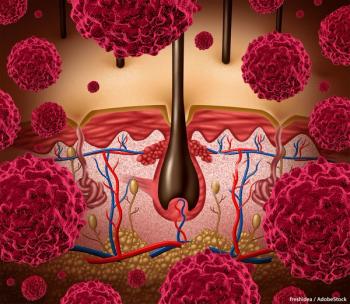
Oncology NEWS International
- Oncology NEWS International Vol 9 No 6
- Volume 9
- Issue 6
Intergroup Melanoma Surgical Trial Validates 2-cm Excision
NEW ORLEANS-Long-term follow-up of patients who underwent surgical excision of intermediate-thickness melanomas offers valuable information regarding the risk of local recurrence, especially as it relates to treatment.
NEW ORLEANSLong-term follow-up of patients who underwent surgical excision of intermediate-thickness melanomas offers valuable information regarding the risk of local recurrence, especially as it relates to treatment.
Charles M. Balch, MD, professor of surgery, Johns Hopkins University, presented the findings at a plenary session of the Society of Surgical Oncology (SSO) Cancer Symposium, on behalf of the Intergroup Melanoma Surgical Trial.
The results were based on 15-year follow-up of 740 patients: 468 patients with 1- to 4-mm melanomas on the trunk or proximal extremities (group A), and 272 patients with lesions on the head, neck, and distal extremities (group B).
Patients in group A were randomized to receive either 2- or 4-cm radial excision margins, while group B patients received 2-cm excisions. Patients were also randomized either to elective lymph node dissection or observation of the nodes.
At the time of the study, the standard of care was to excise all melanomas larger than 1 mm with a 4- to 5-cm margin and a split-thickness skin graft. This study aimed to determine if the margins of excision could be reduced safely; the researchers focused on the incidence of local recurrence, which is significantly related to survival.
Local recurrence (at any time during the course of the disease) was noted in 28 patients: 11 patients (2.3%) from group A and 17 (6.3%) from group B. In 13 patients, local recurrence was the first sign of relapse; most were in group B, probably because of their disease location, Dr. Balch said. There is a statistical correlation between local recurrence and anatomic site, ranging from 1.1% in the proximal extremities to 9.4% for head and neck melanomas, he elaborated.
A local recurrence at any time during progression of metastatic disease carried a 5-year survival rate of only 11% and a 10-year survival of 0%. For patients without a local recurrence, the 10-year survival rate was 86% (P < .0001), Dr. Balch reported.
Factors Affecting Local Recurrence
The extent of margin excision did not make a difference in the risk of local recurrence: 2.1% for the patients receiving a 2-cm excision and 2.6% for those undergoing a 4-cm excision. Management of regional lymph nodesdissection vs observationalso was not a factor in local recurrence, he noted.
Survival also was not affected by margin excision: 10-year survival was 70% after a 2-cm excision and 77% after a
4-cm excision (a nonsignificant difference). Management of nodes also did not influence survival.
Several factors were, however, significantly related to the incidence of local recurrence, with P values of .01 or less, Dr. Balch noted. Increasing tumor thickness among the patients in group B was strongly correlated with local recurrence of disease, especially for lesions 3.1 to 4.0 cm in size.
Another powerful correlate was the presence of ulceration in the primary melanoma in both groups A and B. In group B, ulceration produced an eightfold increase in risk of local recurrence, rising from 2.1% without ulceration to 16.2% when ulceration was present. In group A, risk increased fivefold, from 1.1% to 6.6%, he reported.
By Cox multifactorial regression analysis, the only factor independently correlating with the rate of local recurrence was the presence or absence of ulceration (risk ratio, 4.2; P = .03).
No independent correlation was found for margins of excision, tumor thickness, site, or elective dissection of nodes, in this analysis.
When groups A and B were pooled for analysis, the only additional factor correlating with the incidence of local recurrence was the presence of melanoma on the head or neck, which yielded a 9.4 risk ratio (P < .01).
An important question was whether a wider margin would prevent local recurrence, especially in thicker or ulcerated lesions. While this makes intuitive sense, it was not demonstrated in this study, Dr. Balch stated.
Based on thickness parameters or ulceration, we cant say that wider excision decreases the risk of recurrence, he commented.
The study also examined relapse patterns to determine whether the local recurrences represented retained primary tumor cells or were the first manifestation of distant or stage IV melanoma. In 68% of patients, the next site of relapse occurred at a distant site, usually in the skin or subcutaneous lymph nodes.
The trial results, Dr. Balch concluded, showed that:
A 2-cm radial excision is safe and reduces the need for split-thickness skin graft.
Ulceration and melanomas arising in the head and neck increase the risk of local recurrence as well as mortality.
A local recurrence is associated with a very high risk of subsequent metastases at distant sites.
A local recurrence is probably the first manifestation of stage IV melanoma.
WHO Results With 1-cm Margins
Intergroup coinvestigator Kirby Bland, MD, professor and chairman of surgery, University of Alabama at Birmingham, called the ongoing analysis a very strong contribution to the literature. He noted that Intergroup Melanoma Trial 10 of the World Health Organization (WHO) found that it was safe to excise melanomas up to 2 mm in thickness with a 1-cm margin, and asked Dr. Balch to comment.
Dr. Balch responded that with a 1-cm excision, the WHO trials local recurrence rate for T2 lesions was 6%, compared with less than 1% for lesions of equivalent thickness in the US Intergroup study.
He added that in some patients, he would consider reducing the margin to 1 to 2 cm to avoid the need for primary closure and achieve a better cosmetic result.
Articles in this issue
over 25 years ago
Genentech Issues Warning on Herceptinover 25 years ago
How Physicians Can Effect Changes in Health Care Policyover 25 years ago
Four From Congress Receive Tsongas Awardover 25 years ago
NCI Targets Cancer Disparities With Community-Based Programsover 25 years ago
Mapping Predicts Nodal Status in Colorectal Cancer Patientsover 25 years ago
SSO President Tells Members: ‘Remember Your Core Values’over 25 years ago
HHS Grants $794 Million in Ryan White Funds to Improve HIV Servicesover 25 years ago
Rapid Dose Titration With Controlled-Release Oxycodoneover 25 years ago
Standard-Dose Chemo May Have Long-Term Cognitive EffectsNewsletter
Stay up to date on recent advances in the multidisciplinary approach to cancer.
































































































